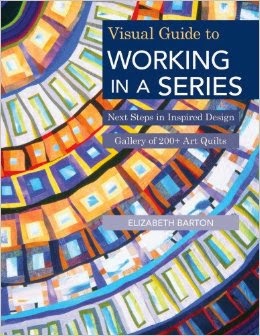 |
| Ambivalence 48"h, 35"w |
Recently I've been asked several times about construction - it seems like an awful lot of people are fusing these days and people want to know what I use. Well, I've never really tried fusing...I haven't needed to...I don't know whether it's the type of quilts I make or my fondness for the stitch or my fear of glue!
I do always work from a sketch, not being fond of racing back and forth to the design wall like a retriever, but my sketch can be pretty rough. However, it does mean I have a very good idea of which pieces are going to go where, and the order in which they can be sewn together.
I usually have two copies of the sketch - one with the values (light, medium and dark). The value sketch is on the design wall next to where I'm blocking out the quilt. Then I have a gridded line drawing that shows the shapes and proportions - it's on the cutting table. The grid helps me to calculate the size of each piece of fabric I cut out. I look at the sketch, calculate the size, add seam allowance, cut out...stroll to the wall and pin it up!
So you can see - for the quilt at the top of the page...once I'd pinned everything up and made sure all the proportions and values were correct, and it looked the way I wanted it to...once that was done, all I had to do was piece those strips together...then piece the strips...
My fabric is sorted by value. and I never pull from my whole stash...once I've decided on a color scheme, I pull out all the fabrics I think I'll use and put the rest away. Too many choices can....well...you know what!! And, I'm not keen on quilts with a rainbow jumble of colors.
 |
| Electric Fields 34"h, 45"w |
I think it's important that you should make work that you personally like!!! Even if your friends and family think it's totally weird. Yes, I've been greeted with many a puzzled look and a "well, what's it supposed to be?"!!! You just have to plough on through that one! The quilt above (currently in the SAQA show Concrete and Grasslands) was shown to 4 friends, two loved it, two hated it - so I guess - on average - it was deemed acceptable! Statistically kidding apart, people definitely thought it was weird...until the perfect show came along ...and then they got it.
For the quilt above I pieced the two big background fabrics... the sky (background) and the rape field (foreground)...then I appliqued the cooling towers onto the horizon and then layered various scraps of silk over the top to make them look beautiful...and no! they are not elephant legs upside down!!
And yes, the bottom fabric is all shibori - arashi shibori - here's a detail:
You can see I like hand stitching!!
well, time for a nice cuppa tea, I think...
If you have been, thanks for reading...and not thinking about elephants! Elizabeth
and....I look forward to reading your comments!

















